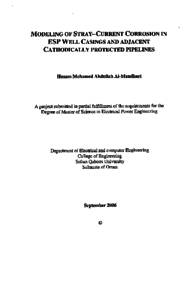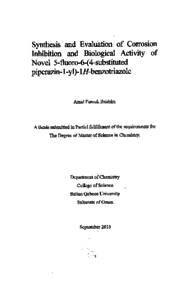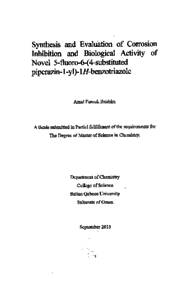Document
Modeling of stray-current corrosion in ESP well casings and adjacent cathodically protected pipelines
Publisher
Sultan Qaboos University
Gregorian
2006
Language
English
English abstract
Cathodic protection (CP) is usually used to prevent such a corrosion. It turns the entire protected structure into the cathode of a corrosion cell and it is used extensively on steel structures in the oil and gas industries (pipelines, well casings and tanks). There are two types of cathodic protection systems, namely, the galvanic and impressed current types. Galvanic cathodic protection systems utilize galvanic anodes, also called "sacrificial anodes", that are electrochemically more active than the structure to be protected. In the impressed-current cathodic protection, the anode is connected to a DC power supply, which regulates the current flow into the anode.
In this project, it is shown that computer modeling and simulation approach enables results to be obtained at the design stage, allowing CP systems to be optimized so that interference can be minimized. Application of the Boundary Element Analysis System (BEASY) software package allowes CP interference to be assessed in terms of the normal current density. BEASY is used to analyze the effect of cathodic interference on stray-current corrosion and also to analyze the corrosion rate of pipeline/well casing arrangments. Different practical cases are simulated, e.g. cathodic interference, anodic interference, induced interference, combined interference, galvanic cells as those occuring at PDO's sites, and other more cases. The corrosion rate has a linear relationship with current density, where a higher value of the anodic current density (current leaving the structure under interference) indicates a higher corrosion rate.
It is concluded from the simulated cases by BEASY that the cathodic interference is more serious than anodic fellow, since the current leaving the pipe close to the protected structure has a high current density. This is due to the localized anodic zone on the foreign pipe. In the case of anodic interference, however, the unprotected structure is closer to the ground bed and it has a cathodic aspect and receives a protection current over well located areas. This current returns to earth at zones remote from the ground bed. Therefore, this type of interference seldom causes severe and localized corrosion. The variation of the current density and the distance of the anode is also studied and it is concluded that stray current increases by increasing the current density of the anode and decreases when the anodes were located far from the structres. The length of the anode is also studied where a well casing is considered to be an anode. It is concludedthat when long anodes (unused well casings) are used, the protection current distribution becomes better. Concerning the stray-current density profile, it is shifted to the lower part of the well casing when using the long anode compared to the normal anode where it covered a lagre area at the top of the well casing. The effect of soil conductivity is also studied and it is concluded that stray current decreases in areas having high conductivity. The software used in this project is helpful in future planning before installing structures in the oil fields, where it gives the user a broad idea on the type of protection needed and the effect of cathodic protection on nearby unprotected metallic structures.
Description
Thesis
Member of
Resource URL
Arabic abstract
لقد أصبح التأكل هو الخطر المتزايد الذي يهدد سلامة منشآت حقول النفط. وتستخدم عادة الحماية الكاثودية لمنع التأكل حيث يحول المنشأة المحمية إلى قطب سالب في خلية التأكل. المنشآت الحديدية تستخدم بكثرة في الصناعات النفطية ( خطوط الأنابيب وأغلفة الآبار والخانات والصهاريج ) وهنالك نظامين للوقاية تستخدم لحماية أنابيب النفط الطريقة الأولى وهي الحماية الجلفنية (Galvanic Cathodic Protection) وتتلخص في أن المنشأة توصل بقطعة من المعدن ذو جهد كهربائي سالب أعلى في الوسط الذي توجد به من جهد المنشأة المراد حمايتها. الواقي سيصبح مصعد وإنه يتأكل في حين تحفظ المنشأة التي ستصبح مهبطا من التأكل، ويسمى أيضا (Sacrificial Anodes). وفي الطريقة الثانية وهي الحماية الكاثودية باستخدام م صدر للتيار المستمر (Impressed Current Protection ) حيث يتم توصل القضيب الموجب (Anode ) بمصدر التيار المستمر (DC) لينظم سريان التيار داخل القضيب الموجب (Anode). وفي هذا المشروع ، قد تم توضيح أن الحاسوب يمكن أن يقدم نموذجا حسابيا والحصول على نتائج في مرحلة التصميم قبل الشروع في التشييد . وهذا يتيح فرصة للحد من التداخل والتشويش الناتج من الحماية الكاثودية باستخدام مصدر للتيار المستمر. وبتطبيق حزمة برامج نظام تحليل عناصر الحدود (BEASY) يسمح بتقدير حماية الكاثودية (CP) بكثافة التيار الكهربائي. تستخدم حزمة برامج نظام تحليل عناصر الحدود (BEASY) لتحليل تداخل عنصر الكاثود على التيار الشارد كما أنه أيضا يستخدم لتحليل معدل التأكل في خطوط الأنابيب وأغلفة الآبار. وقد تم تمثيل عدة عمليات التداخل الكاثودي السالب، وتداخل الأنودي الموجب ، وتدخل التوليفة ، وتدخل المشترك، والخلايا الجلفانية (Galvanic Cell) مثل التي تحدث في مواقع شركة تنمية نفط عمان وحالات أخرى كثيرة. وقد وجد أن معدل معدل حدوث التأكل له علاقة خطية بكثافة التيار حيث أن كثافة التيار العالية في التيار الذي يغادر المنشأة تحت تأثير التداخل) هي مؤشر إلى ارتفاع معدل حدوث التأكل. وقد تم التوصل من خلال عمليات المحاكاة المتعددة في حزمة برامج نظام تحليل عناصر الحدود (BEASY) إلى أن تداخل الكاثودي السالب أكثر خطورة من تداخل الأنودي الموجب، حيث أن هناك تيارا ذا كثافة عالية يخرج من الأنبوب القريب جدا من المنشاة المحمية. وينسب هذا إلى نطاق الأنود المحلي على الأنبوب الغريب. وفي حالة تداخل العنصر الأنودي الموجب، علما أنه المنشأة المحمية قريبة من القضيب الموجب، ويتوقع أن يصيبها التداخل الكاثودي السالب وأنها حصلت على قدر من التيار الواقي في موقع محددة. وهذا التيار يرجع إلى الأنود في مناطق بعيدة عن سطح الأرض القائمة عليه المنشأة. وهذا النوع من التداخل نادرا ما يسبب تأكل موضعي. وقد تمت أيضا دراسة تغير كثافة التيار ومسافة الأنود، وقد ثبت من خلال الدارسة أن التيار الشارد يزداد أيضا بزيادة كثافة التيار في الأنود الموجب ويقل عندما يكون الأنود بعيدا عن المنشأة. كما تمت دراسة طول الأنود الموجب حيث يعتبر غلاف البئر الغير مستخدم هو الأنود. وتبين أنه كلما كان الأنود المستخدم طويلا ، فإن توزيع التيار الواقي سيكون أكثر انتظاما. أما فيما يخص التيار الشارد الموجب والمسبب للتأكل سيتم تحويله إلى الجزء الأسفل من غلاف البئر في حالة استخدام الأنود الطويل مقارنة باستخدام الأنود العادي، حيث في النوع الأخير يغطي مساحة واسعة في أعلى قمة غلاف البئر. لقد تمت أيضا دراسة قدرة الأرض على توصيل التيار ونقله وثبت أن التيار الشارد يقل في المناطق التي يكون فيها قدرة التربة التوصيلية عالية. إن البرنامج الذي استخدم في هذا المشروع سوف يساعد في التخطيط قبل الشروع في تركيب المنشأت في مواقع حقول النفط حيث أنها يعطي المستخدم فكرة عن نوعية الحماية الكاثودية المطلوب استخدامها لمكافحة التآكل وكذلك أثر التآكل على أقرب منشأة غير محمية.
Category
Theses and Dissertations



